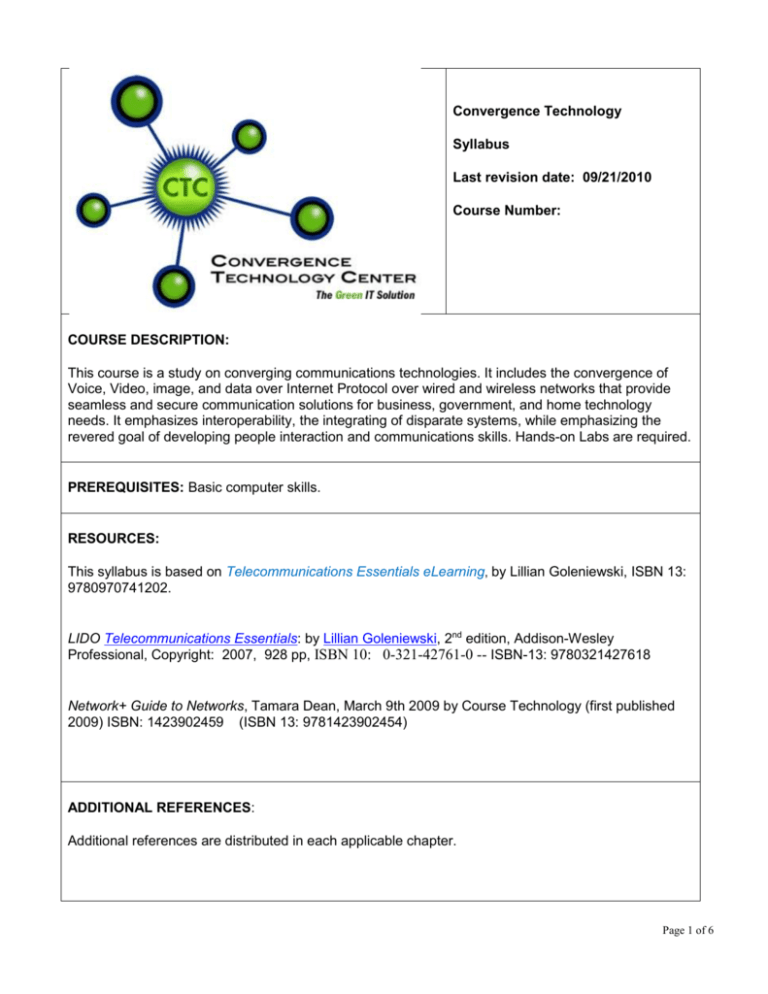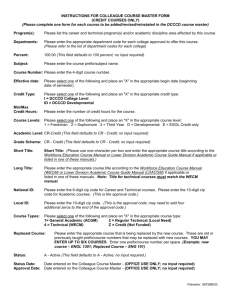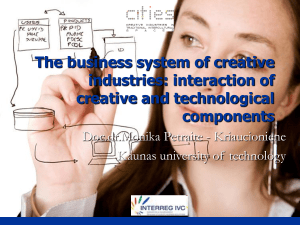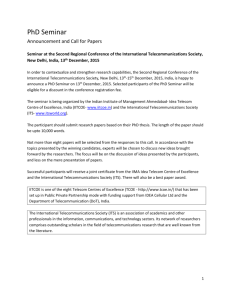2010 - Convergence Technology
advertisement

Convergence Technology Syllabus Last revision date: 09/21/2010 Course Number: COURSE DESCRIPTION: This course is a study on converging communications technologies. It includes the convergence of Voice, Video, image, and data over Internet Protocol over wired and wireless networks that provide seamless and secure communication solutions for business, government, and home technology needs. It emphasizes interoperability, the integrating of disparate systems, while emphasizing the revered goal of developing people interaction and communications skills. Hands-on Labs are required. PREREQUISITES: Basic computer skills. RESOURCES: This syllabus is based on Telecommunications Essentials eLearning, by Lillian Goleniewski, ISBN 13: 9780970741202. LIDO Telecommunications Essentials: by Lillian Goleniewski, 2nd edition, Addison-Wesley Professional, Copyright: 2007, 928 pp, ISBN 10: 0-321-42761-0 -- ISBN-13: 9780321427618 Network+ Guide to Networks, Tamara Dean, March 9th 2009 by Course Technology (first published 2009) ISBN: 1423902459 (ISBN 13: 9781423902454) ADDITIONAL REFERENCES: Additional references are distributed in each applicable chapter. Page 1 of 6 WECM LEARNING OUTCOMES (Note WECM is Texas-specific – other states may want to include all outcomes as merely outcomes): 1. 2. 3. 4. Describe the various technologies used in telecommunications. Identify the architectures used in the telecommunications industry. Name the key telecommunications industry protocols Explain the application of technologies, architectures, and protocols used in the telecommunications industry. 5. Describe signaling and its importance to telecommunications. 6. Identify pro and con characteristics of Mobility emphasizing security. 7. Describe 1G, 2G, 3G, 4G, LTE, WiMAX and their role in present and future Mobility. ADDITIONAL LEARNING OUTCOMES RECOMMENDED: 8. Explain the various access technologies: PAN, HAN, LAN, CAN, MAN, and WAN including associated cellular and wireless network architectures. 7. Describe the principles of PSTN switching including the functionality of IP softswitches 8. Discuss the need and importance of transport in telecommunications. 9. Explain the reasons for the convergence of voice, data, image, and multimedia. 10. Explain how the Internet Protocol is key to convergence. 11. Appraise the importance of quality of service with regard to availability, reliability, and serviceability of a voice network. 12. Design a solution to a case study problem and create a presentation describing the results. 13. Describe the components involved in a “smart home” home network. 14. Describe the technology associated with using light waves to carry messages. 15. Explain the impact on human social behavior due to communications mobility 16. To communicate the importance of conferencing for the purpose of collaboration. Understand the components and demonstrate how to establish a collaboration session. 17. Understand and describe how energy savings can be a benefit from convergence technology and lend itself to “Green IT”. Page 2 of 6 COURSE ASSESSMENT: Class lectures/PowerPoints will cover and expand upon the assigned reading material. Labs will be used for hands-on experience. Regularly scheduled quizzes, tests, and exams will be administered by your instructor. Assignments, suggested schedules, and supplementary material to be distributed on the first day of class and posted to an online site provided by your instructor. Chapter Quizzes/Exercises 20% Grade Values: Exams/Chapter tests 40% A 90-100 Lab exercises/Projects 20% B 80-89 Presentation/Case Study 10% C 70-79 Class participation/ Daily Work 10% D 60-69 Final Grade 100% F 59Below COURSE SCHEDULE: (Sequence of instruction recommended based on learning outcomes) Ch 1 2 Major Topics Learning Outcomes Reading Assignments Human–Machine Interactions Embedded Devices Intelligent Wearables Traffic Patterns Describe the various technologies used in telecommunications. (WECM #1) Ch 1 – Introduction to Telecommunications The Electromagnetic Spectrum Analog and Digital, Multiplexing Media: Twisted-Pair, Coaxial Cable, Microwave, Satellites, Fiber Optics Discuss the need and importance of transport in telecommunications. (WECM # 8) Ch 2 – Introduction to Transmission Quiz - Ch 1 Explain the reasons for the convergence of voice, data, image, and multimedia. (WECM #9) Page 3 of 6 3 Establishing Communication Identify the architectures used in the Ch 3 – Switching and Channels: Circuit Switching, telecommunications industry. (WECM #2) Routing Messages Packet Switching PDH & SDH/SONET Infrastructure Describe the principles of PSTN switching Quiz – Ch 2 including the functionality of IP soft switches. (WECM #7) 4 Signaling Systems, SS7, and Intelligent Networks Describe signaling and its importance to telecommunications. (WECM #5) Ch 4 – Telephony and Signaling Systems Quiz – Ch 3 5 6 7 8 9 Explain how the Internet Protocol is key Data Communication Traffic to convergence. (WECM #10) Data Transmission OSI and TCP/IP Reference Models Ch 5 – Data Networks and Traffic Discuss the need and importance of LAN Transport and Standards transport in telecommunications. (WECM LAN Access and Topologies # 8) LAN Switches, VLANs, and Bridges Ch 6 – LANs (Local Area Networks) Circuit-Switched, Leased Line Networks ISDN, Packet-Switched networks, X.25, Frame Relay and ATM Explain the reasons for the convergence of voice, data, image, and multimedia. (WECM #9) Ch 7 – WANs (Wide Area Networks) Internet and Routing Protocols Internet Architecture, and Infrastructure Subnetting: IPv4, IPv6; DNS, QoS Service Providers Name the key telecommunications industry protocols. (WECM #4) Ch 8 – Introduction to the Internet Explain how the Internet Protocol is key to convergence. (WECM #10) Mid-Term Exam – Chs (1 – 7) IPT Network Architecture, QoS VoIP Call Signaling Protocols Digital Voice, ENUM VPNs: Layer 3, 2, Security Unified communications, IP voice and IPTV, Telepresence Describe signaling and its importance to telecommunications. (WECM #5) Ch 9 – Introduction to IP Telephony Explain how the Internet Protocol is key to convergence. (WECM #10) Quiz – Ch 8 Quiz – Ch 4 Quiz – Ch 5 Quiz – Ch 6 Appraise the importance of quality of service with regard to availability, reliability, and serviceability of a voice network. WECM #11) Page 4 of 6 To communicate the importance of conferencing for the purpose of collaboration. Understand the components and demonstrate how to establish a collaboration session. WECM #16 10 Television Basics, Digital TV Standards The Broadband Infrastructure Quality of Service, MPLS Virtualization Cloud Computing (workstations, servers, Storage) Discuss the need and importance of transport in telecommunications. (WECM # 8) Ch 10 – Broadband, IPTV, QoS, and MPLS Quiz – Ch 9 Explain the reasons for the convergence of voice, data, image, and multimedia. (WECM #9) Appraise the importance of quality of service with regard to availability, reliability, and serviceability of a voice network. (WECM #11) 11 Optical Networking Elements : Switches, Edge, Core Describe the technology associated with using light waves to carry messages. (WECM #14) Ch 11 – Introduction to Fiber Optic Networks Quiz – Ch 10 12 13 DSL , Cable TV Networks, Packet Cable, Fiber Solutions, Wireless Broadband, HANs PANs, CANs, MANs Broadband PLT Explain the various access technologies: PAN, HAN, LAN, CAN, MAN, and WAN including associated cellular and wireless network architectures. (WECM #6) Antennas, Wireless Bandwidth, Spectrum Utilization, Spread Spectrum Discuss the need and importance of transport in telecommunications. (WECM # 8) Ch 12 – Wired and Wireless Broadband Quiz – Ch 11 Describe the components involved in a “smart home” home network. (WECM #13) Ch 13 – Wireless Spectrum, Radios. and antennas Quiz – Ch 12 14 Cellular: 2G, 2,5G, 3G, 4G, WiMax,LTE, mobile security Digital Cellular Radio Enhanced Data Services Describe signaling and its importance to telecommunications. (WECM #5,#6,#7) Ch 14 – Cellular Services and Standards Design a solution to a case study problem and create a presentation describing the Quiz - Ch 13 Page 5 of 6 results. (WECM #12 Broadband Wireless 3G Standards: UMTS, TD-SCDMA, CDMA Solutions 15 16 BFWA, WLANs IEEE 802.11a,b,g,n IEEE 802.16, WiMax, WiBro and Mobile-Fi VoWLAN Integration of WLANs and Cellular Networks, RFID Mesh Networks Name the key telecommunications industry protocols. (WECM #3) Ch 15 - Wireless Network Architecture Mobile IP, IP Multimedia Subsystem (IMS), Applications, Mobile Video, Mobile TV, and Content Explain how the Internet Protocol is key to convergence. (WECM #10) Ch 16 – Wireless and Mobility Explain the impact on human social behavior due to communications mobility. WECM #15) Comprehensive Final – Chs (1 – 16) Quiz – Ch 14 ACKNOWLEDGEMENTS Syllabus developed by: Peter Brierley, faculty member of Collin College, Mike Harsh, faculty member of Collin College, Karen Cheng, Associate faculty member of Collin College, and Robert Wright, Business Consultant. This syllabus was developed with support from National Science Foundation. Project leader was Ann Beheler, PI for the NSF ATE grant 0402356. Non-exclusive copyright © 2007: Non-exclusive copyright is retained by Collin College on behalf of the National Science Foundation ATE Grant 0402356. Any opinions, findings, and conclusions or recommendations expressed in this material are those of the author(s) and do not necessarily reflect the views of the National Science Foundation Page 6 of 6




